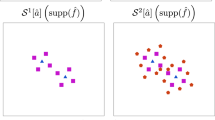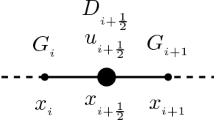Abstract
Discretization of (linearized) convection-diffusion-reaction problems yields a large and sparse non symmetric linear system of equations,
In this work, we compare the computational behavior of the Induced Dimension Reduction method (IDR(s)) (Sonneveld and van Gijzen, SIAM J Sci Comput 31(2):1035–1062, 2008), with other short-recurrences Krylov methods, specifically the Bi-Conjugate Gradient Method (Bi-CG) (Fletcher, Conjugate gradient methods for indefinite systems. In: Proceedings of the Dundee conference on numerical analysis, pp 73–89, 1976), restarted Generalized Minimal Residual (GMRES(m)) (Saad and Schultz, SIAM J Sci Stat Comput 7:856–869, 1986), and Bi-Conjugate Gradient Stabilized method (Bi-CGSTAB) (van der Vorst, SIAM J Sci Stat Comput 13(2):631–644, 1992).
Access this chapter
Tax calculation will be finalised at checkout
Purchases are for personal use only
Similar content being viewed by others
References
R. Fletcher, Conjugate gradient methods for indefinite systems, ed. by G.A. Watson. Proceedings of the Dundee Biennal Conference on Numerical Analysis 1974 (Springer, New York, 1975), pp. 73–89
Y. Saad, Iterative Methods for Sparse Linear Systems, 2nd edn. (Society for Industrial and Applied Mathematics, Philadelphia, 2003)
Y. Saad, M. Schultz, GMRES: a generalized minimal residual algorithm for solving nonsymetric linear systems. SIAM J. Sci. Stat. Comput. 7, 856–869 (1986)
G.L.G. Sleijpen, D.R. Fokkema, BiCGstab(ℓ) for linear equations involving Unsymmetric matrices with complex spectrum. Electron. Trans. Numer. Anal. 1, 11–32 (1993)
G.L.G. Sleijpen, P. Sonneveld, M.B. van Gijzen, Bi-CGSTAB as an induced dimension reduction method. Appl. Numer. Math. 60, 1100–1114 (2010)
V. Simoncini, D.B. Szyld, Interpreting IDR as a Petrov-Galerkin method. SIAM J. Sci. Comput. 32 (4), 1898–1912 (2010)
G.L.G. Sleijpen, H.A. van der Vorst, Maintaining convergence properties of bicgstab methods in finite precision arithmetic. Numer. Algorithms 10 (2), 203–223 (1995)
G.L.G. Sleijpen, M.B. van Gijzen, Exploiting BiCGstab(ℓ) strategies to induce dimension reduction. SIAM J. Sci. Comput. 32 (5), 2687–2709 (2010)
P. Sonneveld, M.B. van Gijzen, IDR(s): a family of simple and fast algorithms for solving large nonsymmetric systems of linear equations. SIAM J. Sci. Comput. 31 (2), 1035–1062 (2008)
H.A. van der Vorst, Bi-CGSTAB: a fast and smoothly converging variant of Bi-CG for the solution of nonsymmetric linear systems. SIAM J. Sci. Stat. Comput. 13 (2), 631–644 (1992)
M.B. van Gijzen, P. Sonneveld, Algorithm 913: an elegant IDR(s) variant that efficiently exploits bi-orthogonality properties. ACM Trans. Math. Softw. 38 (1), 5:1–5:19 (2011)
Author information
Authors and Affiliations
Corresponding author
Editor information
Editors and Affiliations
Rights and permissions
Copyright information
© 2016 Springer International Publishing Switzerland
About this paper
Cite this paper
Astudillo, R., van Gijzen, M.B. (2016). The Induced Dimension Reduction Method Applied to Convection-Diffusion-Reaction Problems. In: Karasözen, B., Manguoğlu, M., Tezer-Sezgin, M., Göktepe, S., Uğur, Ö. (eds) Numerical Mathematics and Advanced Applications ENUMATH 2015. Lecture Notes in Computational Science and Engineering, vol 112. Springer, Cham. https://doi.org/10.1007/978-3-319-39929-4_29
Download citation
DOI: https://doi.org/10.1007/978-3-319-39929-4_29
Published:
Publisher Name: Springer, Cham
Print ISBN: 978-3-319-39927-0
Online ISBN: 978-3-319-39929-4
eBook Packages: Mathematics and StatisticsMathematics and Statistics (R0)




